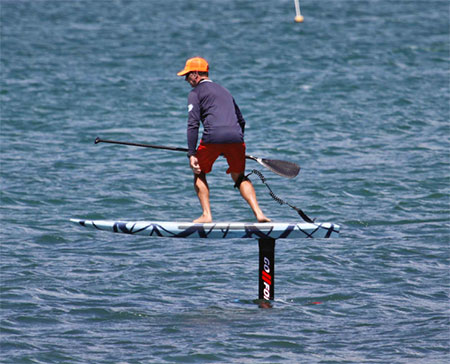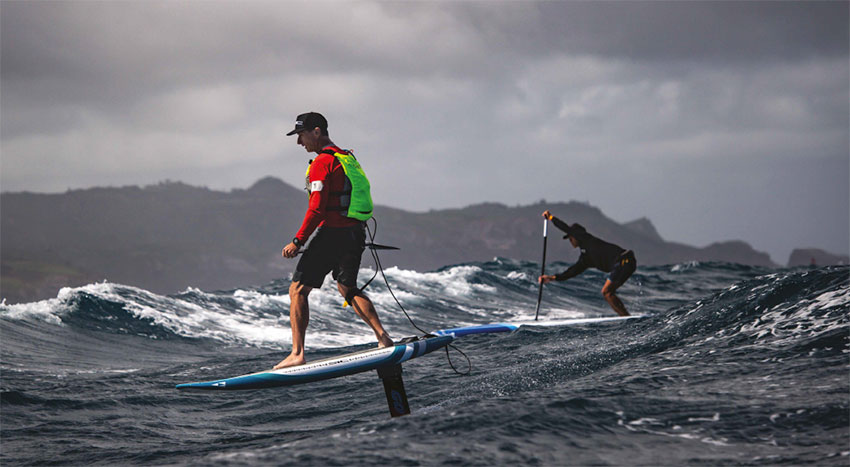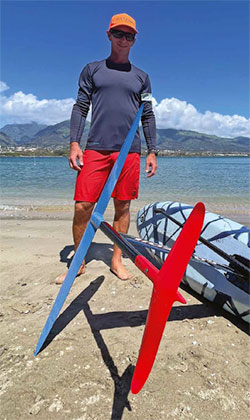From Stand Up Magazin Ausgabe issue #22 (2022)
As a reminder for those who don’t remember exactly how foiling started: The history of foiling began like that of Stand Up Paddling – on the North Shore of Maui. For more on that, feel free to read the interview with Dave Kalama in the last issue of Stand Up Magazine. This story is not about rehashing old content, but about how SUP and foil are connected.
One of the first to join Downwind SUP is Jeremy Riggs. With the start of foiling, Jeremy also one of the first. While downwinders are much easier with a SUP, it’s a little more difficult with a foil. Even after a few years, since the trend started on Maui, the number of those who have mastered the technique is still relatively small. The interest, on the other hand, is very high.
Since last year, Jeremy has taken notice of people’s interest and has been giving lessons at Kahului Harbor on Maui. Every Tuesday morning, people paddle and practice getting off the water with the SUP and transitioning into foil.
I too had the pleasure of trying this out. If you are looking for a good cardio and endurance workout, this is it. The interaction of the paddle and leg movements is very important. It’s like a SUP sprint race: Short cadence while paddling and good footwork is required.

The whole sequence of movements must be coordinated and the rhythm must be right. Then it’s actually not that difficult. The right material also plays a role, of course. The sport is still so young and that’s why we’re still in the experimental phase. That’s what Dave Kalama told us in the last issue. He is working on boards that are easier to pump out of the water.
A large front foil is also very important, of course, because just like with an airplane: The bigger the wing, the lower the takeoff speed.
Just because we are still experimenting and SUP downwind foiling (and flatwater) is not yet mastered by many, doesn’t mean we can’t dream of a great future. Jeremy is convinced, as I am, that as the number of people who have mastered it grows, there will be a desire to race.
When there are downwind races again on Maui, we will see how many people will compete with a SUP foil. It will be even more exciting when we hopefully have another Molokai2Oahu paddle race in 2023.
Sometime in the future there will be people who will use this technique on a lake. Then there will be a SUP race organizer who will say, “Let’s have the SUP Foilers compete in a sprint race.” That will then be the starting point when SUP race foiling will be incorporated into the SUP racing categories as a serious SUP discipline. How long will that take? We can’t say exactly, but it will certainly take a little longer than the spread of SUP. We’ve been foiling for a good six years now, and it’s only now that foiling (not wind powered) is starting to spread into land locked places.
For all pioneers and enthusiasts, here’s a little tutorial: Jeremy pumps himself out of the water in less than 20 meters and then flies about 100 meters across the bay. How do I do it?
The EQUIPMENT:
Board: Dave Kalama’s special SUP foil board (dimensions are mostly secret), length: about 7 feet, volume: about 95 liters, width: about 18″. Such dimensions are for full pros like Jeremy, user-friendly dimensions start at a width of 25″.
Foil Set-up: GoFoil. The front wing corresponds to approx. 1,300 cm2. Beginners, however, are on the road with 2,200 cm2 or more.
Paddel: A conventional SUP paddle, head high or a hand’s width overhead.
The technique:
Jeremy starts in surf stance and pushes the board down as the paddle is pulled back. As the paddle is brought forward, the whole board is unweighted.
In the picture, it’s nice to see Jeremy’s back foot comes off the board as he unloads. This is where the right board is enormously helpful. Dave Kalama designs his hull so that the board really jumps out of the water when you unload it.
After two or three paddle strokes, you pick up speed and get a good rhythm. That’s how you notice, that you’re really pump the board out of the water. The better you get, the fewer paddle strokes it will take for the board to come completely out of the water.
Now that you’re in the flying phase, you’re gliding through the water with virtually no resistance.
After a year, some of the questions in this story have been answered. The number of people who master this technique is increasing every day, even on lakes. At the boot show in January, the SUP Foil Flat Water Start was shown for the first time to a wide audience and caused great astonishment among the spectators. You will read the continuation of the story in issue #24.



